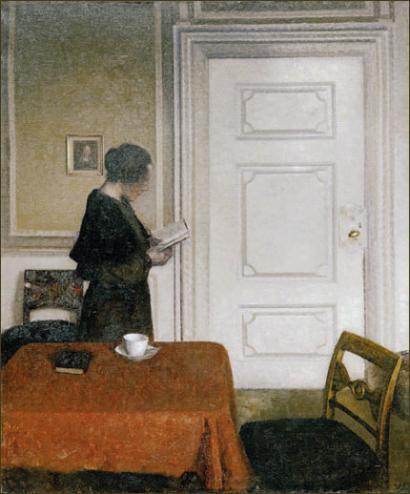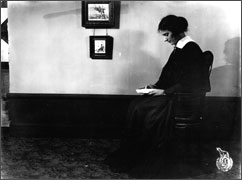
Vilhelm Hammershøi, Dona llegint / Woman Reading (Strandgade 30), 1908, Oil on canvas
Kunstmuseet Brundlund Slot, Aabenraa, Denmark |
|
CENTRE DE CULTURA CONTEMPORANIA BARCELONA
Montalegre 5, 08001 Barcelone
INFORMATION:
Tél. +34 93 306 41 00
Fax +34 93 306 41 01
Site: www.cccb.org
OPENING HOURS:
Tuesday to Sunday: 11 a.m. to 8 p.m.
Closed on Mondays except public holidays.
PRICES OF ADMISSION:
Admission: 4,40 € Concessions:.3,30 € Free admission: under 16’s, the unwaged, Friends of CCCB and the first Wednesday of every month. Concessions on Wednesday (except public holidays) and for senior citizens and students.
CURATORS:
Anne-Birgitte Fonsmark,
Annette Rosenvold Hvidt, Casper Tybjerg and Jordi Balló
PRESS CONTACT:
Mònica Muñoz – Ana Sánchez
Montalegre, 5 – 08001 Barcelona
Tel. 93 306 41 23/ 93 306 41 00
premsa@cccb.org www.cccb.org

|
This exhibition brings together for the first time the work of the two most universal Danish artists of all time: the painter Vilhelm Hammershøi - Copenhagen, 1864–1916 - and the filmmaker Carl Theodor Dreyer - Copenhagen, 1889–1968. It is the first time Hammershøi’s work has been shown in Spain, represented here by 36 essential pieces. To date, anthological shows of the Danish painter have only been presented in Paris, New York and Hamburg. The exhibition also comprises 12 audiovisuals showing excerpts from Dreyer’s films, and presents photographs and documents on loan from the two artists’personal archives, highlighting the process of reflection and work involved in their creations.
A student who paints in a truly strange way.
Hammershøi’s drawing teacher said of him: I have a student who paints in a truly strange way. I don’t understand him, but I think he will be a prestigious artist and I try not to influence him. The work of Hammershøi is confined to a few pictorial themes: portraits of family and friends, interiors of the places where he lived, monumental buildings in Copenhagen and London, and the landscapes of the Danish island of Sealand. These motifs appear repeatedly in his paintings. They portray no action, but are impregnated with an essential aura: beyond extreme calm and immobility, we perceive the threat of something indefinable, close to death. Hammershøi used a muted palette, dominated by tones of grey.
A relentless quest for spiritual truths and beauty
Carl Theodor Dreyer is the foremost figure in Danish cinema. His films refine the expressivity of light and shadow and are characterized by his relentless quest for spiritual truths and beauty. In the course of 40 years, he filmed both silent and speaking films, including The President (Præsidenten, 1918), Michael (Mikaël, 1924), Master of the House (Du Skal Ære Din Hustru, 1925), The Passion of Joan of Arc (La Passion de Jeanne d’Arc, 1927), Vampyr (1932) and Day of Wrath (Vredens Dag, 1943). In 1955, Dreyer was awarded first prize in the Venice Film Festival with the film The Word (Ordet) . His last film, Gertrud (1964), was highly controversial, but was awarded the Danish Bodil Prize for the Best Film of the Year. Today it is considered one of the ten best films in the history of the cinema.
Analogies
The exhibition aims firstly to publicize two very well known creators, though they are little known beyond Danish borders. The Barcelona show is only the fourth international exhibition to be devoted to Hammershøi. Dreyer’s films are screened only very occasionally, and this is one of the first times they have been presented in an exhibition. The second challenge is to show the strong visual and creative relations between the artists, and in their methods, their intimate understanding of art as well as their aesthetic similarities. Hammershøi and Dreyer share many thematic and formal analogies...They are both convinced that the greatest dramatic intensity is found in interiors - of a house, an image, a face. Their treatment of the human figure, particularly the female form: the enigmatic women with their backs to us in domestic interiors refer to the contemplation and ecstasy of the characters and their personal dramas, and even contain the hint of death. The dominance of light in the scene is impeccable in both artists. Hammershøi knew how to paint it, while Dreyer gave it cadence. And exteriors partake the same quality: the landscapes, charged with a very special atmosphere, or the exteriors perceived through sculptural figures, windows and doors closed on the interiors represented.
Hammershøi’s works in the light of Dreyer.
Dreyer was probably Hammershøi’s best and maybe his only true heir. However, the exhibition does not just highlight the analogies between them, but also establishes the explicit link between their bodies of work in a two-way relationship. It helps us to understand some of the creative forms of the filmmaker by means of a knowledge of the painter’s work, and to better understand the essence of the painter in the light of the films by Dreyer that follow. The show begins with Dreyer, underlining the importance of light in his films. It continues with Hammershøi’s paintings, presented one by one to highlight the intimate relationship between the spectator and the work and to convey the central ideas of his painting: austerity, sobriety, silence and slowness. Dreyer remains present throughout the section devoted to the works of Hammershøi, turning a visit to the exhibition into a sensorial experience in which the spectator can admire Hammershøi’s works in the light of Dreyer.
Illustration : DREYER El president / /The President ( Præsidenten ), 1918
To see more illustrations, click on VERSION FRANCAISE at the top of this page
|









